人教新目标(Go for it)版 七年级上 Unit 6 Do you like bananas? Section A 词汇课件 (共27张PPT)
文档属性
| 名称 | 人教新目标(Go for it)版 七年级上 Unit 6 Do you like bananas? Section A 词汇课件 (共27张PPT) |  | |
| 格式 | pptx | ||
| 文件大小 | 2.9MB | ||
| 资源类型 | 教案 | ||
| 版本资源 | 人教新目标(Go for it)版 | ||
| 科目 | 英语 | ||
| 更新时间 | 2022-07-12 15:42:59 | ||
图片预览

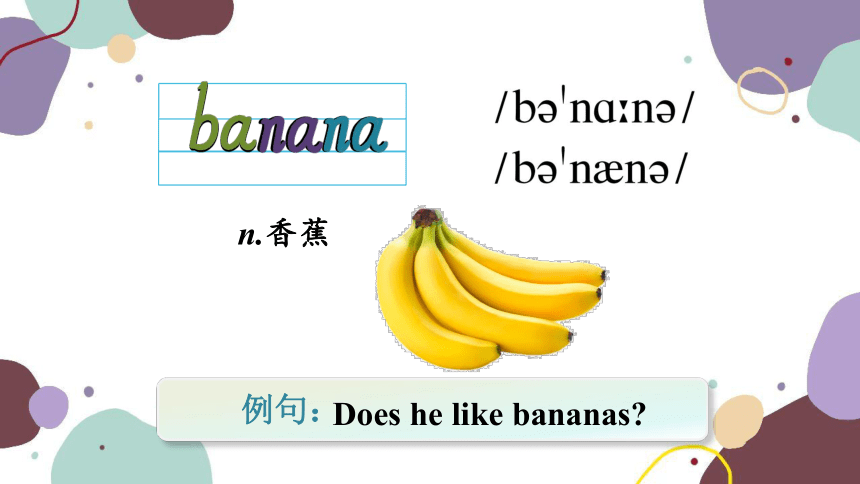
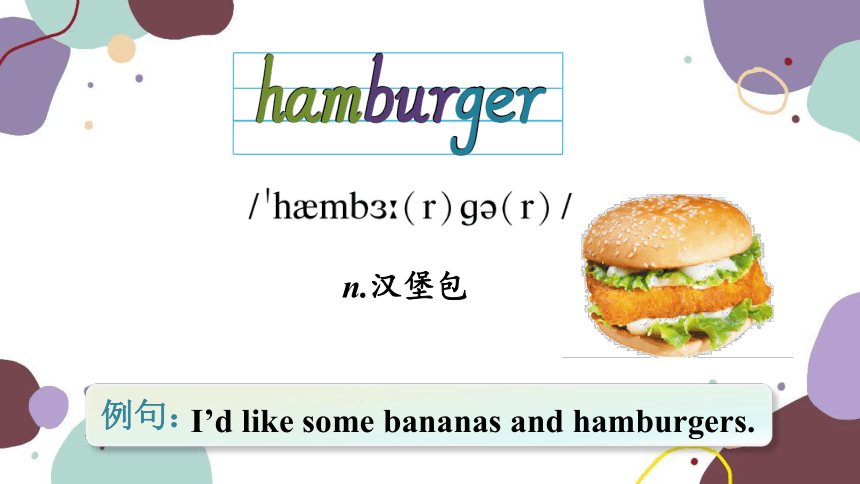
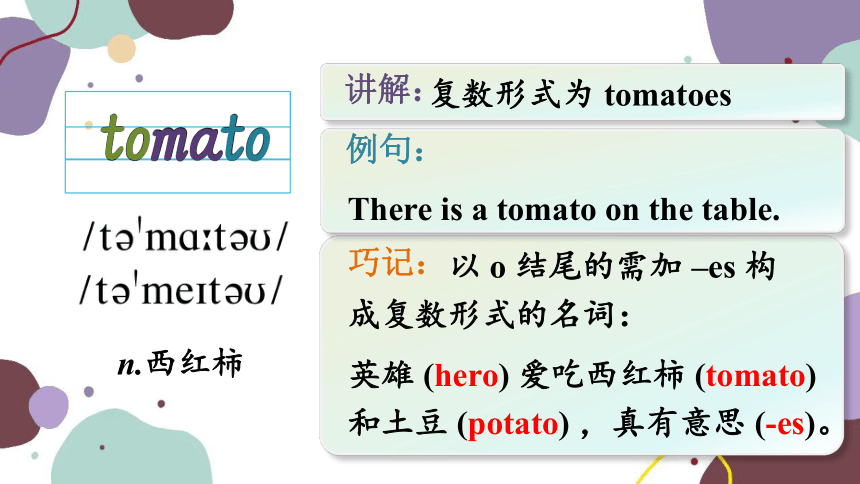
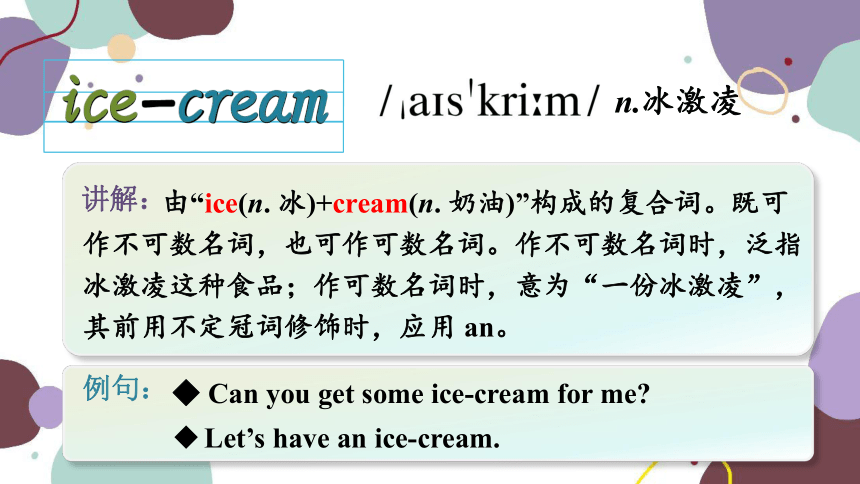
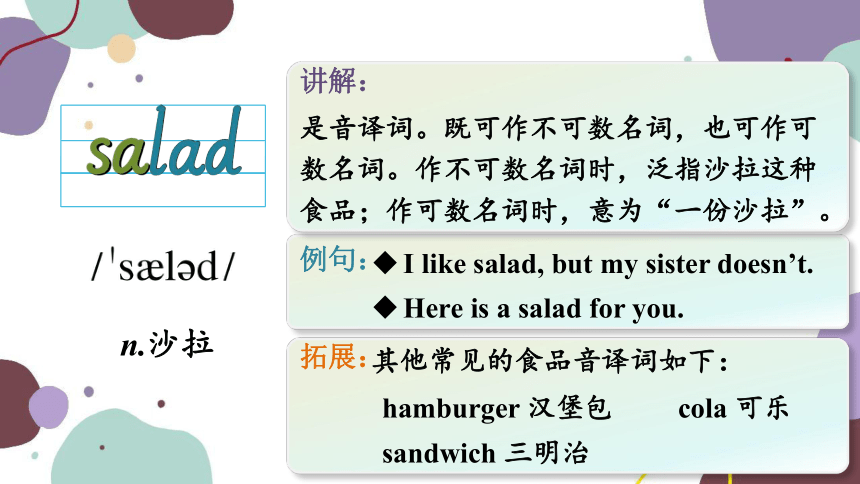
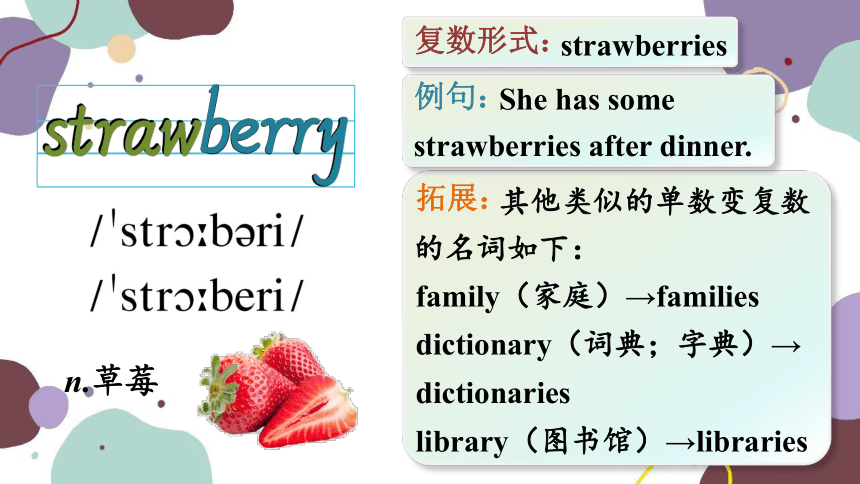
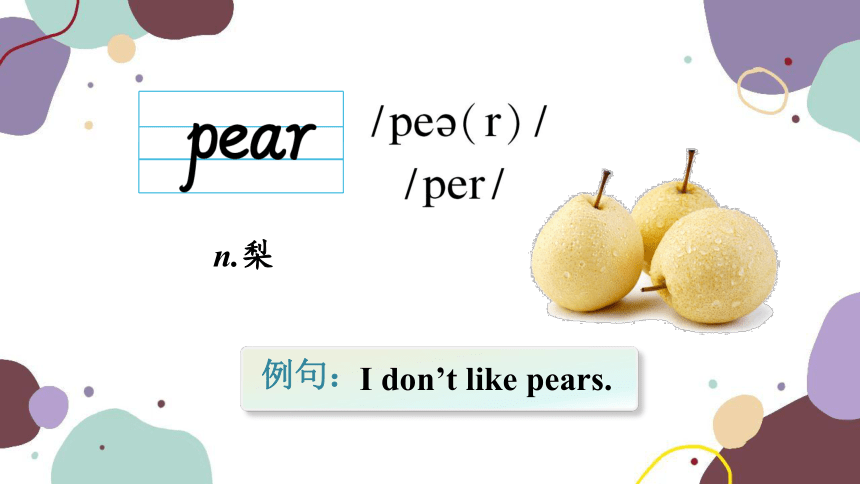
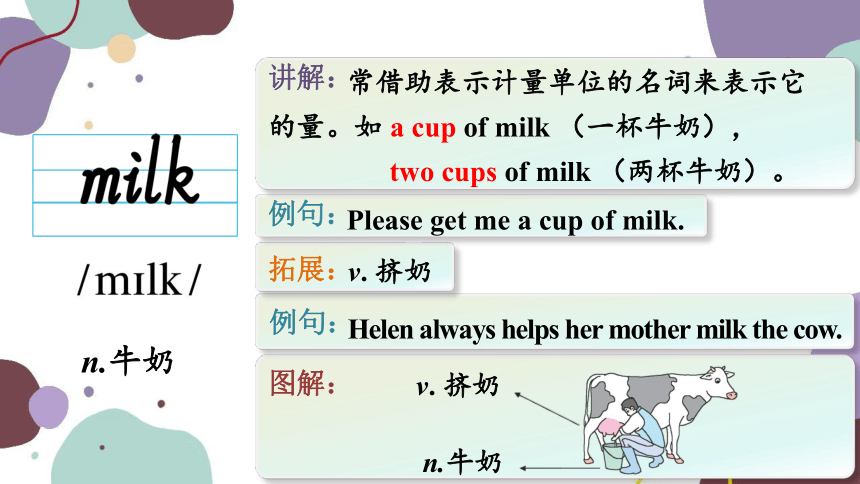
文档简介
(共27张PPT)
Unit 6 Do you like bananas
Section A
n.香蕉
例句:
Does he like bananas
n.汉堡包
例句:
I’d like some bananas and hamburgers.
n.西红柿
例句:
There is a tomato on the table.
巧记:
以 o 结尾的需加 –es 构成复数形式的名词:
讲解:
复数形式为 tomatoes
英雄 (hero) 爱吃西红柿 (tomato)和土豆 (potato) ,真有意思 (-es)。
n.冰激凌
例句:
◆ Can you get some ice-cream for me
Let’s have an ice-cream.
讲解:
由“ice(n. 冰)+cream(n. 奶油)”构成的复合词。既可作不可数名词,也可作可数名词。作不可数名词时,泛指冰激凌这种食品;作可数名词时,意为“一份冰激凌”,其前用不定冠词修饰时,应用 an。
n.沙拉
例句:
I like salad, but my sister doesn’t.
Here is a salad for you.
讲解:
是音译词。既可作不可数名词,也可作可数名词。作不可数名词时,泛指沙拉这种食品;作可数名词时,意为“一份沙拉”。
拓展:
其他常见的食品音译词如下:
hamburger 汉堡包 cola 可乐 sandwich 三明治
其他类似的单数变复数的名词如下:
n.草莓
例句:
She has some strawberries after dinner.
复数形式:
strawberries
拓展:
family(家庭)→families
dictionary(词典;字典)→
dictionaries
library(图书馆)→libraries
n.梨
例句:
I don’t like pears.
n.牛奶
例句:
Please get me a cup of milk.
拓展:
v. 挤奶
讲解:
常借助表示计量单位的名词来表示它的量。如 a cup of milk (一杯牛奶),
two cups of milk (两杯牛奶)。
例句:
Helen always helps her mother milk the cow.
图解:
v. 挤奶
n.牛奶
n.面包
例句:
◆ I usually have an egg and some bread
for breakfast.
Please give me two pieces of bread.
讲解:
不能与不定冠词a或具体的数词连用,表示具体的面包数量时,可以借助于 piece。如 a piece of bread (一片面包),three pieces of bread (三片面包)。
n.生日
例句:
◆ Do you know her birthday
Can you come to my birthday party
构成:
birth (n. 出生)+day (n. 一天;一日)
短语:
birthday cake 生日蛋糕
birthday party 生日聚会
birthday card 生日贺卡
birthday present 生日礼物
n. (中午或晚上吃的)正餐
例句:
It’s 6:00. Let’s have dinner.
辨析:
dinner 一般指一天中较为正式的一餐,可以晚上吃,也可以中午吃。在西方国家,晚餐一般是一天中最为丰富的一餐,因此 dinner 常用来指晚餐。此外,dinner一词比较正式,邀请朋友赴晚宴通常用它。
短语:
have dinner 吃晚餐 have… for dinner 晚餐吃……
dinner 与 supper
supper 只表示“晚餐”,不如 dinner 正式。
n.周;星期
例句:
What about going to Beijing next week
短语:
next week下周
(该短语前不加介词)
思考;思索
讲解:
其中about是介词,后接名词、代词或动词 –ing 形式。
例句:
You should think about your parents.
拓展:
与think相关的其他常见短语如下:
think of 想出;想起
think over 仔细考虑
think back 回想起
(2)可数名词:食物。通常表示特定种类的食品,其复数形式为foods。
(1)不可数名词:食物。表示食物的总称。作主语时,谓语动词用第三人称单数形式。
n.食物
例句:
◆ The food here is great.
We need healthy food.
讲解:
sea foods 海产食品
讲解:
短语:
healthy food 健康食品
junk food 垃圾食品 fast food 快餐
短语:
adv.当然;肯定;一定
例句:
—Can you play sports with me
—Sure.
讲解:
表示同意别人的建议或请求,相当于 OK, of course 或certainly。
(提出建议)……怎么样
例句:
How about the yellow jacket
拓展:
讲解:
用于提出建议或请求。 其中 about 是介词,其后可接名词、代词或动词 -ing 形式。
英语中其他常用于提建议的句型如下:
(1) Let’s… 咱们……吧。
(2) Why not… /Why don’t you… (你)为什么不……呢?
n.蔬菜
例句:
◆ I like vegetables.
Let’s have some vegetable soup.
作定语修饰其他名词时,要用单数形式
n.水果
例句:
My parents like to have some fruit every day.
Apples and bananas are my favorite fruits.
讲解:
作不可数名词时,表示水果的总称;作可数名词时,表示水果的种类,其复数形式为 fruits。
adj.正确的;适当的
讲解:
(1) 形容词 正确的;适当的
在句中作表语或定语。此时反义词为wrong, 意为“错误的”。
I think he is right.
(2) 形容词 右边的
此时反义词为left, 意为“左边的”。
Can you see a dog in the right picture
(3) 名词 右边;右方
此时反义词为left, 意为“左边;左方”。
Helen is on my right.
n.苹果
例句:
This is an apple.
Here are some apples for you.
读音以元音音素开头,其前用不定冠词时,应用 an
注意:
adv.那么
例句:
Then, let’s go home.
I can’t find my dog. Where is it then
讲解:
(1)那么:可位于句首或句末,用于缓和语气。
例句:
I want to have an apple, and then drink some milk.
讲解:
(2)那时;然后
n.蛋;鸡蛋
例句:
I like eggs and milk for breakfast.
图解:
an egg two eggs
n.胡萝卜
例句:
Do you like carrots
图解:
carrot carrots
n.大米;米饭
例句:
图解:
—What does your brother like
for dinner
—He likes rice and vegetables.
n.鸡肉
例句:
How about having some chicken
拓展:
(2)可数名词:鸡
讲解:
(1)不可数名词:鸡肉
例句:
Eric’s grandma has some chickens.
图解:
chicken 的一词多义:
鸡肉(不可数名词)
鸡(可数名词)
conj. (引出评论或问题)那么
例句:
So do you like strawberries
讲解:
(2)因此;所以:表示因果关系。
讲解:
(1)那么:位于句首,通常用于引出评论或问题。
例句:
Bruce likes playing soccer, so his father gets him a soccer ball.
Unit 6 Do you like bananas
Section A
n.香蕉
例句:
Does he like bananas
n.汉堡包
例句:
I’d like some bananas and hamburgers.
n.西红柿
例句:
There is a tomato on the table.
巧记:
以 o 结尾的需加 –es 构成复数形式的名词:
讲解:
复数形式为 tomatoes
英雄 (hero) 爱吃西红柿 (tomato)和土豆 (potato) ,真有意思 (-es)。
n.冰激凌
例句:
◆ Can you get some ice-cream for me
Let’s have an ice-cream.
讲解:
由“ice(n. 冰)+cream(n. 奶油)”构成的复合词。既可作不可数名词,也可作可数名词。作不可数名词时,泛指冰激凌这种食品;作可数名词时,意为“一份冰激凌”,其前用不定冠词修饰时,应用 an。
n.沙拉
例句:
I like salad, but my sister doesn’t.
Here is a salad for you.
讲解:
是音译词。既可作不可数名词,也可作可数名词。作不可数名词时,泛指沙拉这种食品;作可数名词时,意为“一份沙拉”。
拓展:
其他常见的食品音译词如下:
hamburger 汉堡包 cola 可乐 sandwich 三明治
其他类似的单数变复数的名词如下:
n.草莓
例句:
She has some strawberries after dinner.
复数形式:
strawberries
拓展:
family(家庭)→families
dictionary(词典;字典)→
dictionaries
library(图书馆)→libraries
n.梨
例句:
I don’t like pears.
n.牛奶
例句:
Please get me a cup of milk.
拓展:
v. 挤奶
讲解:
常借助表示计量单位的名词来表示它的量。如 a cup of milk (一杯牛奶),
two cups of milk (两杯牛奶)。
例句:
Helen always helps her mother milk the cow.
图解:
v. 挤奶
n.牛奶
n.面包
例句:
◆ I usually have an egg and some bread
for breakfast.
Please give me two pieces of bread.
讲解:
不能与不定冠词a或具体的数词连用,表示具体的面包数量时,可以借助于 piece。如 a piece of bread (一片面包),three pieces of bread (三片面包)。
n.生日
例句:
◆ Do you know her birthday
Can you come to my birthday party
构成:
birth (n. 出生)+day (n. 一天;一日)
短语:
birthday cake 生日蛋糕
birthday party 生日聚会
birthday card 生日贺卡
birthday present 生日礼物
n. (中午或晚上吃的)正餐
例句:
It’s 6:00. Let’s have dinner.
辨析:
dinner 一般指一天中较为正式的一餐,可以晚上吃,也可以中午吃。在西方国家,晚餐一般是一天中最为丰富的一餐,因此 dinner 常用来指晚餐。此外,dinner一词比较正式,邀请朋友赴晚宴通常用它。
短语:
have dinner 吃晚餐 have… for dinner 晚餐吃……
dinner 与 supper
supper 只表示“晚餐”,不如 dinner 正式。
n.周;星期
例句:
What about going to Beijing next week
短语:
next week下周
(该短语前不加介词)
思考;思索
讲解:
其中about是介词,后接名词、代词或动词 –ing 形式。
例句:
You should think about your parents.
拓展:
与think相关的其他常见短语如下:
think of 想出;想起
think over 仔细考虑
think back 回想起
(2)可数名词:食物。通常表示特定种类的食品,其复数形式为foods。
(1)不可数名词:食物。表示食物的总称。作主语时,谓语动词用第三人称单数形式。
n.食物
例句:
◆ The food here is great.
We need healthy food.
讲解:
sea foods 海产食品
讲解:
短语:
healthy food 健康食品
junk food 垃圾食品 fast food 快餐
短语:
adv.当然;肯定;一定
例句:
—Can you play sports with me
—Sure.
讲解:
表示同意别人的建议或请求,相当于 OK, of course 或certainly。
(提出建议)……怎么样
例句:
How about the yellow jacket
拓展:
讲解:
用于提出建议或请求。 其中 about 是介词,其后可接名词、代词或动词 -ing 形式。
英语中其他常用于提建议的句型如下:
(1) Let’s… 咱们……吧。
(2) Why not… /Why don’t you… (你)为什么不……呢?
n.蔬菜
例句:
◆ I like vegetables.
Let’s have some vegetable soup.
作定语修饰其他名词时,要用单数形式
n.水果
例句:
My parents like to have some fruit every day.
Apples and bananas are my favorite fruits.
讲解:
作不可数名词时,表示水果的总称;作可数名词时,表示水果的种类,其复数形式为 fruits。
adj.正确的;适当的
讲解:
(1) 形容词 正确的;适当的
在句中作表语或定语。此时反义词为wrong, 意为“错误的”。
I think he is right.
(2) 形容词 右边的
此时反义词为left, 意为“左边的”。
Can you see a dog in the right picture
(3) 名词 右边;右方
此时反义词为left, 意为“左边;左方”。
Helen is on my right.
n.苹果
例句:
This is an apple.
Here are some apples for you.
读音以元音音素开头,其前用不定冠词时,应用 an
注意:
adv.那么
例句:
Then, let’s go home.
I can’t find my dog. Where is it then
讲解:
(1)那么:可位于句首或句末,用于缓和语气。
例句:
I want to have an apple, and then drink some milk.
讲解:
(2)那时;然后
n.蛋;鸡蛋
例句:
I like eggs and milk for breakfast.
图解:
an egg two eggs
n.胡萝卜
例句:
Do you like carrots
图解:
carrot carrots
n.大米;米饭
例句:
图解:
—What does your brother like
for dinner
—He likes rice and vegetables.
n.鸡肉
例句:
How about having some chicken
拓展:
(2)可数名词:鸡
讲解:
(1)不可数名词:鸡肉
例句:
Eric’s grandma has some chickens.
图解:
chicken 的一词多义:
鸡肉(不可数名词)
鸡(可数名词)
conj. (引出评论或问题)那么
例句:
So do you like strawberries
讲解:
(2)因此;所以:表示因果关系。
讲解:
(1)那么:位于句首,通常用于引出评论或问题。
例句:
Bruce likes playing soccer, so his father gets him a soccer ball.
同课章节目录
- starters 预备篇(2012秋审查)
- Unit 1 Good morning !
- Unit 2 What’s this in English?
- Unit 3 What color is it ?
- Unit 1 My name's Gina.
- Section A
- Section B
- Unit 2 This is my sister.
- Section A
- Section B
- Unit 3 Is this your pencil?
- Section A
- Section B
- Unit 4 Where's my schoolbag?
- Section A
- Section B
- Unit 5 Do you have a soccer ball?
- Section A
- Section B
- Unit 6 Do you like bananas?
- Section A
- Section B
- Unit 7 How much are these socks?
- Section A
- Section B
- Unit 8 When is your birthday?
- Section A
- Section B
- Unit 9 My favorite subject is science.
- Section A
- Section B
